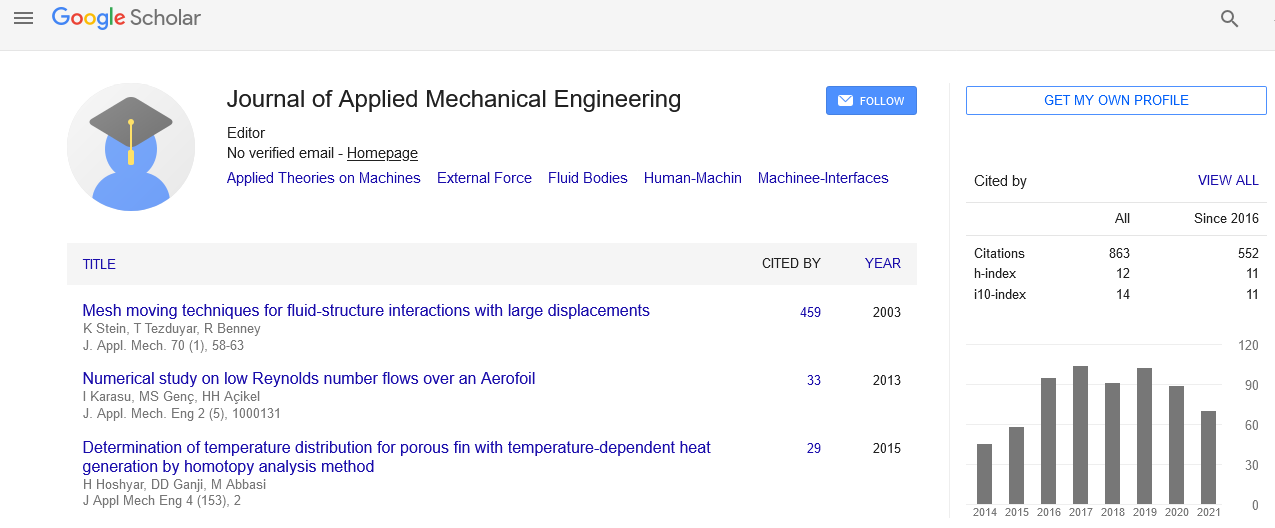Indexed In
- Genamics JournalSeek
- JournalTOCs
- CiteFactor
- RefSeek
- Hamdard University
- EBSCO A-Z
- OCLC- WorldCat
- Publons
- Google Scholar
Useful Links
Share This Page
Journal Flyer

Open Access Journals
- Agri and Aquaculture
- Biochemistry
- Bioinformatics & Systems Biology
- Business & Management
- Chemistry
- Clinical Sciences
- Engineering
- Food & Nutrition
- General Science
- Genetics & Molecular Biology
- Immunology & Microbiology
- Medical Sciences
- Neuroscience & Psychology
- Nursing & Health Care
- Pharmaceutical Sciences
Perspective - (2023) Volume 12, Issue 1
Insights of Heat Transfer Through Various Metallic Loops
Elizabeth Radnus*Received: 02-Jan-2023, Manuscript No. JAME-23-19984; Editor assigned: 04-Jan-2023, Pre QC No. JAME-23-19984 (PQ); Reviewed: 18-Jan-2023, QC No. JAME-23-19984; Revised: 23-Jan-2023, Manuscript No. JAME-23-19984 (R); Published: 03-Feb-2023, DOI: 10.35248/2168-9873.23.12.456
Description
Heat exchangers are heat transfer devices which are commonly used to transfer energy from one fluid to another in an enclosed space or region. Heat exchangers find a variety of applications in day to day life, such as refrigerators, air conditioners, desktop computers, industries etc. The study of such systems is so wide spread that it is a part of mechanical engineering. Owing to the large variety of heat exchangers available, it is wise to study such systems employing various criteria of classification for the sake of brevity.
In the present study, the classification of heat exchangers based on the type of convection occurring at the hot and cold fluid sides is of prime interest. Based on the criteria of the type of convection occurring within the heat exchanger, it can be classified as a forced convection heat exchanger, a mixed/ combined convection heat exchanger or a free convection heat exchanger system. The classification chart of heat exchangers based on the criteria of the type of convection occurring at the heat exchange section. It is to be noted that as one progresses from forced to combined to free convection heat exchange systems the complexity increases. The increase in the complexity is attributed to the enhanced coupling between the temperature and velocity fields from forced to free convection heat exchange systems. In a forced convection heat exchange system, the velocity and temperature fields are uncoupled making the study of such systems much easier to model and understand.
A Natural Circulation Loop (NCL) with the constant temperature boundary condition is an example of a combined convection heat exchange system and a Coupled Natural Circulation Loop (CNCL), a Passive Residual Heat Removal System (PRHRS) and a Liquid Metal Fast Breeder Reactor (LMFBR) are examples of a free convection heat exchange systems. Natural circulation is a buoyancy-driven phenomenon that occurs in a closed conduit present in a body force field (gravitational, magnetic or centrifugal) when subjected to an external thermal stimulus. A Natural Circulation Loop (NCL) is a device with circular or rectangular geometry that operates based on the natural circulation process when thermally stimulated at the heating and cooling sections (heat flux or internal heat generation or temperature boundary condition) of the loop, with the rest of the loop generally being insulated from the surroundings.
Conclusion
A Coupled Natural Circulation Loop (CNCL) is a device which is constructed from two NCLs, which are coupled thermally via a common heat exchanger section. The component NCLs are not hydraulically linked; hence, the energy transfer between the two NCLs is solely due to thermal coupling at the heat exchanger section. In a CNCL system the energy transferred to the primary loop is transmitted to the secondary loop through convection at the common heat exchange section and finally transferred to the heat sink of the secondary loop. Depending on the orientation of the common heat exchanger section with respect to gravity, the CNCL is classified as a vertical CNCL or a horizontal CNCL. For a vertical CNCL, the common heat exchange section is parallel to the gravitational field and the gravitational field is perpendicular to the common heat exchange section for a horizontal CNCL. Perspective Correspondence
Citation: Radnus E (2023) Insights of Heat Transfer Through Various Metallic Loops. J Appl Mech Eng. 12:456.
Copyright: © 2023 Radnus E. This is an open-access article distributed under the terms of the Creative Commons Attribution License, which permits unrestricted use, distribution, and reproduction in any medium, provided the original author and source are credited.

